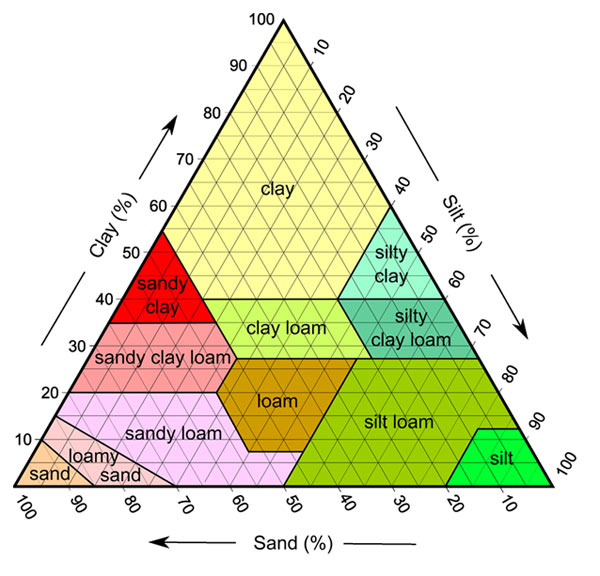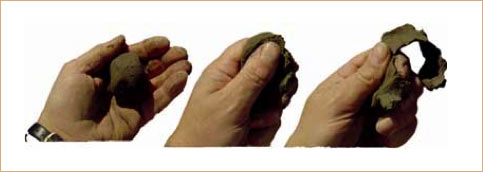 Classic soil types chart by the USDA.
Classic soil types chart by the USDA.Image from Wikipedia.
Click on image for detail.
A clay soil is defined as one in which more than 30% of the mineral particles measure 0.002mm or less in diameter. Such soils typically have an extremely sticky texture, and are considered hard to work. Their texture makes them very heavy and intractable. Clay soils tend to be very slow draining in winter, and to bake extremely hard in summer, but they are usually very rich in essential plant nutrients.
A sandy soil is defined as one in which 35% of the mineral particles are between 0.10mm and 0.50mm in diameter. Such soils are typically fast draining, and low in essential plant nutrients, these having been largely leached away by very rapid drainage. Sandy soils are, however, very easy to work and often warm up early in the spring making them very useful for growing early vegetables.
Loams are defined as soils in which one third of the mineral particles are clay, one third sand and one third silt. Loam soils are the ideal from a horticultural point of view, combining the best qualities of clay soils with the best qualities of sand soils, and ameliorating the deficiencies of both. If you are fortunate enough to have a loam soil, try and preserve its condition.
A range of soils lie between the three basic soil types described above. In total, twelve categories are used to describe soil texture.
Extreme Soil Types
These soils generally occur under extreme climatic or geological conditions. They are not common but many gardeners do have to contend with them.
Stony soils are defined as soils which have over 35% of their mineral particles at least 2mm in diameter. Often the particles are very much larger. Stony soils are almost totally unable to retain moisture and lack essential plant nutrients.
Peat soils have no mineral particles of a measurable size. They are composed entirely, or almost entirely of vegetation that has decayed under anaerobic (airless) conditions. Peat soils occur mainly in areas of extremely high rainfall, are usually extremely acid and contain very few essential plant nutrients.
Muck soils occur in dried up boglands which have not had enough time or enough plants for peat to form. They usually contain a very high proportion of silt particles but no humus and they are consequently virtually barren.
Gumbo or adobe soils are found in the west and far west regions of the USA in areas of very low rainfall. They are characterized by their extreme alkalinity. These soils are similar to clay in mineral particle size, and are usually extremely rich in essential plant nutrients. However, they generally contain insufficient moisture to make the nutrients readily available to the plants. The extreme alkalinity of these soils may also poison plants.
Determining Soil Type
When you take over a new garden it is wise to have an analysis of the soil done. You can have it done professionally with a soils testing lab that's run by your local government. Or you can do it much more cheaply yourself with one of the soil testing kits that are readily available in garden shops or garden centers. These kits will tell you how much your soil is deficient in nitrogen, phosphate, potash or lime, and how much of each of these essential plant foods should be applied to bring your soil into proper balance.
Another method: Put a little soil in the palm of your hand, moisten it gradually, rubbing it and molding it with each addition of water until it reaches the point when you can mold it easily but it does not have any free water and will not stick to a polished surface. Press and mold the soil between your fingers and thumb several times and decide: how gritty or smooth it is, how sticky it is, whether it is plastic-like and how much 'polish' you can get on the surface. Grittiness is due to the presence of sand; smoothness is due to silt; stickiness, plasticity and cohesion are due to clay. Next roll the soil between the palms of your hands and try to form a ball. Note how easy this is. Then try to produce a sausage-like thread, and if this is possible, try to form the thread into a ring. By comparing your observations with the table below you can get some estimation of the soil texture.
A Quick Guide to Soil Types
| Texture | Grittiness | Smoothness | Stickiness |
Ball & Thread Formation |
| Sand | extremely gritty | not smooth | not sticky | balls collapse easily |
| Loamy Sand | extremely gritty | not smooth | not sticky | balls difficult to form |
| Sandy Loam | very gritty | not smooth | not sticky | balls stick together, no threads |
| Loam | moderately gritty | slightly smooth | slightly sticky | balls stick together, threads difficult to form |
| Clay Loam | slightly gritty | slightly smooth | moderately sticky | forms balls, threads, and rings |
| Silt Loam | very little grittiness | very smooth | slightly sticky | balls stick together, threads difficult to form |
| Silt | very little grittiness | extremely smooth | slightly sticky | balls stick together, threads difficult to form, slight polish |
| Clay | very little grittiness | not smooth | extremely sticky | balls, threads and rings easily formed; plenty of polish |
Resources
Classifying soils is a science unto itself. Here's a short synopsis about soil classifications at Wikipedia.
This author at AgVerra adds two more soil types: Peaty and Saline.
The Web Soil Survey, run by the NRCS (National Resources Conservation Service) offers soil maps for 95% of the U.S.
Smooshing Soils Like an Expert is another way to determine your soil texture. An image from the article:

This looks like a clay soil!